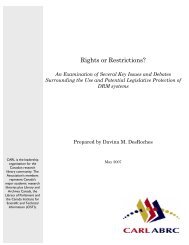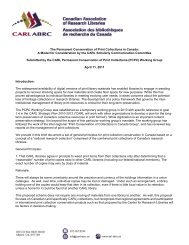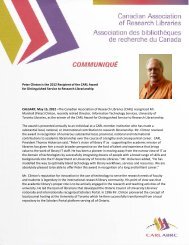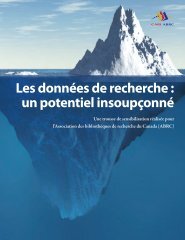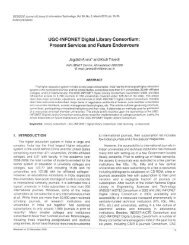PDF - CARL - ABRC
PDF - CARL - ABRC
PDF - CARL - ABRC
Create successful ePaper yourself
Turn your PDF publications into a flip-book with our unique Google optimized e-Paper software.
willingness to consider the goals of the groups, rather than just the<br />
individual institutions. 23 Seaman describes this attitude in his case<br />
study of the Preservation and Access Service Center for Colorado<br />
Academic Libraries (PASCAL) collaborative storage facility. He notes<br />
that, “each library brought unique collections and user demands to the<br />
partnership, but it also was recognized that such a collaborative<br />
facility could contribute to a shared storage solution and could offer<br />
unique services for the benefit of a much larger community.” 24<br />
Preventing duplication can prove complicated, as PASCAL contributors<br />
learned. “Subtle” differences between practices, such as one<br />
institution cataloguing by unique title and another by series, can make<br />
avoiding duplication difficult. 25<br />
Shelton also identified potential barriers to the success of<br />
collaborative storage facilities. 26 These included resistance by participating<br />
libraries or uneven participation by member libraries,<br />
difficulties agreeing on governance and priorities, and uneven funding<br />
sources. However, advisory committees can help win librarians'<br />
support for a project. It is also important to make sure that the<br />
academic communities do not lose access to the materials they need<br />
for research and teaching.<br />
Affects on Research and Use<br />
There is general agreement that most scholarly research would not<br />
be disrupted by the removal of older print journal volumes; patrons<br />
do not usually need access to the print version of a serial when it is<br />
available electronically. Tyler and Zillig reported that older print<br />
journals rarely circulated, leading them to conclude that volumes<br />
“simultaneously available electronically…could profitably be moved<br />
to storage without causing patrons any great distress.” 27 Kaplan,<br />
Steinberg and Doucette reported similar findings after examining use<br />
patterns, citations, and interlibrary loan statistics of older print<br />
journals. 28 Newby's survey of mathematicians revealed “a majority” of<br />
respondents preferred access to the electronic version, when both<br />
formats of the same resources were available. 29 McCarthy likewise<br />
described “an evolving absence of need” for print journals, and noted<br />
“little or no reaction” when access was further limited for serials in<br />
remote storage. 30 Like their patrons, many librarians are seeing less<br />
and less value in holding on to print versions of electronic journals. 31<br />
There are still library users and librarians, however, who have<br />
concerns about the relative value and reliability of digital resources.<br />
Some scholars continue to assert that libraries should maintain access<br />
to print copies, due to the specific nature of their research, or because<br />
of their individual reading styles. McKinzie, citing Guthrie, states<br />
“most faculty agree that… ‘it will always be crucial for libraries to<br />
maintain hard-copy archives’” 32 As one of Newby's surveyed<br />
mathematics scholars wrote, “…sometimes it is fun to sit in the<br />
library reading old journals.” 33 Other users found the print versions<br />
easier to skim through. Carignan spoke with faculty members who<br />
argued that they could not conduct their research using electronic<br />
copies. 34 Their reasons included being able to scan tables of contents<br />
faster or needing to examine paper and ink quality to obtain more<br />
evidence about printing dates and motives. For some faculty, it seems<br />
the print journal as an artifact still has relevance.<br />
“Some scholars continue to assert that libraries<br />
should maintain access to print copies, due to<br />
the specific nature of their research, or because<br />
of their individual reading styles.”<br />
McDonald also adds that libraries have an archival responsibility. 35<br />
Research institutions need to keep copies of resource materials in<br />
their original format in order to best serve current and future scholars.<br />
244 The Journal of Academic Librarianship<br />
Nichols and Smith, 36 Schottlaender et al., 37 Henebry, Safley, and<br />
George, 38 Crawford, 39 and Weston and Acton 40 all provide compelling<br />
arguments for retention of materials in original paper format,<br />
including incomplete content, the accuracy of content, and the<br />
divergence of content in dual-publishing models. They also raise<br />
concerns about the loss of advertising, book reviews, and color in<br />
electronic versions.<br />
There are also lingering worries about image-reproduction<br />
technologies for electronic formats, despite recent improvements in<br />
this area. Electronic journal backfiles may have inferior-image quality,<br />
rendering them less useful for researchers in certain fields. 41 Even<br />
amongst scholars with an expressed preference for electronic<br />
journals, Newby found complaints about the quality of figures. 42<br />
Bracke and Martin's research had similar findings. 43 Comparing print<br />
journals to electronic by looking at text and images, they uncovered<br />
“the reality that the electronic backfiles were not always adequate<br />
substitutes for print copies.” 44 Despite their findings, a “significant<br />
amount of print content was ultimately withdrawn.” 45 It must be<br />
noted that some publishers, such as Elsevier, are starting to address<br />
these concerns. A project is underway to improve the quality of<br />
images and missing pages and issues, and they report, for example,<br />
that missing issues are now down to .1%. 46<br />
Notwithstanding these concerns, surveys by JSTOR 47 and HeinOnline<br />
48 show that some libraries are discarding material. The JSTOR<br />
survey collected data from 207 institutions. Results revealed that 97<br />
institutions had discarded some of their titles, while another 47<br />
institutions had plans to do so in the future. HeinOnline's 2006 survey<br />
showed that of 74 respondents, 17 (23%) were discarding print<br />
volumes duplicated in HeinOnline, and 9 of 66 respondents (14%) had<br />
plans to discard print volumes. Interestingly, the number of<br />
respondents discarding volumes did not rise substantially over the 3<br />
years, with 23% discarding in 2006, 18% discarding in 2005, and 23%<br />
discarding in 2004.<br />
Digital Resource Repositories —<br />
A Contributing Factor<br />
Adding yet another dimension to the issue of print collection<br />
storage is the argument that rather than focusing efforts on long-term<br />
print collection storage, academic libraries should instead be<br />
concentrating on establishing and maintaining repositories of digital<br />
collections. It is unclear how many library-based efforts to establish<br />
digital repositories are underway. According to a 2008 survey of<br />
library directors in the United States, even though digital preservation<br />
was considered important, 66% of respondents were “not yet<br />
participating in an e-journal archiving initiative.” 49 The survey also<br />
showed that the directors were unsure just how urgent e-journal<br />
preservation was and that they were uncertain how to proceed with<br />
digital preservation. 50<br />
“Adding yet another dimension to the issue of<br />
print collection storage is the argument that<br />
rather than focusing efforts on long-term print<br />
collection storage, academic libraries should<br />
instead be concentrating on establishing and<br />
maintaining repositories of digital collections”<br />
Differing views between libraries and publishers on the meaning<br />
of ownership and the meaning of perpetual access create significant<br />
difficulties for libraries trying to establish their own digital archives. 51<br />
Libraries are often required to go through a complex process of<br />
establishing legal ownership of the digital content they wish to




